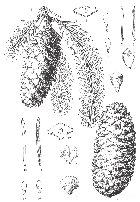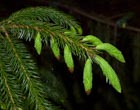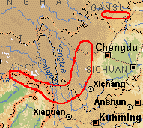Picea brachytyla
(Franchet) E. Pritzel 1901
Common names
Sargent spruce (Farjon 1990); 麦吊云杉 mai diao yunshan [Chinese] (Wu and Raven 1999).
Taxonomic notes
Picea brachytyla belongs to Clade II B of Ran et al. (2006), which primarily includes species from northeast Asia and the Himalaya-Hengduan mountains.
Synonymy:
In this treatment, there are two varieties, the type and var. complanata.
Synonymy for Picea brachytyla var. brachytyla (Wu and Raven 1999):
- Abies brachytyla Franchet 1899;
- Picea brachytyla var. rhombisquamea Stapf;
- Picea ascendens Patschke;
- Picea brachytyla var. latisquamea Stapf.
- Picea pachyclada Patschke;
- Picea sargentiana Rehder et E.H. Wilson;
- Picea brachytyla var. pachyclada (Patschke) Silba.
Synonymy for Picea brachytyla var. complanata (Masters) Cheng ex Rehder (Wu and Raven 1999):
- Picea complanata Masters 1906;
- Picea likiangensis (Franchet) E. Pritzel var. linzhiensis W.C. Cheng et L.K. Fu f. bicolor W.C. Cheng et L.K. Fu.
Description
Trees to 30(-50) m tall and 100(-200) cm dbh, with a pyramidal crown that becomes cylindrical and somewhat irregular with age. Bark gray or gray-brown, longitudinally fissured into thick, square plates or irregularly flaking. Branchlets pendulous, pale yellow or brownish yellow, turning brownish yellow or brown, finally gray. Leaves directed forward and closely appressed on upper side of branchlets, spreading and almost pectinate on lower side, linear, slightly curved or straight, flattened, 10-25×1-1.5 mm, slightly keeled on both sides, stomatal lines 5-7 in each of 2 white or pale bands adaxially, apex acute or mucronate. Seed cones green, red- or purple-brown, maturing dull brown or brown tinged purplish, ovoid-oblong, 6-10(-12)×3-4 cm. Seed scales obovate-oblong or rhombic, 1.4-2.2×1.1-1.3 cm, base cuneate, distal margin usually recurved, sometimes elongate. Seeds ca. 12 mm including wing. Pollination April-May, seed maturity September-October (Wu and Raven 1999).
The varieties are distinguished as follows (Wu and Raven 1999):
| 1. Seed cones green before maturity; leaves thin; bark grayish brown, longitudinally fissured into thick, square plates | var. brachytyla |
| 1. Seed cones red- or purple-brown before maturity; leaves thick; bark pale gray or gray, irregularly flaking | var. complanata |
Distribution and Ecology
China: S. Gansu, S Shaanxi, NW Hubei, W Sichuan, NW Yunnan & SE Xizang; N Burma; the Assam Himal in India (Farjon 1990). This species forms a prominent forest belt in moist mountains of SW China at 2600-3100 m (Liu 1971). Across its broad range, it can be found at 1300-3800 m elevation, typically growing in a cold and wet monsoonal climate with annual precipitation of 1000-2500 mm (wetter to the S) on grey-brown mountain podzols. It is commonly found with Abies spp., Picea likiangensis, Tsuga spp. and Larix potaninii (Farjon 1990). In W Sichuan I found it and var. complanata in association with Betula albosinensis, a shrubby bamboo, and many species of Rhododendron.
Hardy to Zone 8 (cold hardiness limit between -12.1°C and -6.7°C) (Bannister and Neuner 2001).
Where I saw P. brachytyla growing in Sichuan, it occupied an ecological role similar to that of Picea sitchensis in forests of the Pacific Northwest. The climate was very wet, supporting dense growths of moss and a thick forest understory; the trees grew to large size and formed a closed canopy; seedlings primarily grew on nurse logs derived from fallen overstory trees; understory trees grew old as advance regeneration, with umbrella-shaped crowns and slender stems; and the understory was dominated by ericaceous shrubs.
Remarkable Specimens
The largest I have encountered was ca. 50 m tall and 203 cm dbh, a double-butted tree sampled at Hailuogou Glacier Park, Sichuan, China. Diameters exceeding 180 cm are fairly common in this area. The oldest I found, also at Hailuogou Glacier Park, had 606 rings in the measured, crossdated core (collected 1989).
Ethnobotany
An important timber species within its native range, it is also cultivated for afforestation (Wu and Raven 1999).
I made an exploratory dendrochronology collection in April 1989 at Hailuogou Glacier Park in Sichuan, but it did not yield any publications.
Observations
The main trail to the glacier at Hailuogou Glacier Park, Sichuan, China, passes through several impressive stands of this species. The park is served by bus service from Chengdu to Moxi (a two-day ride when I did it in 1989). In Moxi one can acquire guides for the hike into the mountains. It is about a one-day trip to the area of the big trees and another day to the timberline and glacier. Cabins and food service are available within the park.
Remarks
The epithet is from the Greek for short, brachy-, and "having lumps or projections," -tyla.
Both the type and var. complanata are listed by the WCMC as vulnerable. It is "a widespread species [that] is experiencing increasing rates of logging and deforestation throughout the species' range. Population declines are not documented but are believed to be considerable" (WCMC 1998).
Citations
Farjon, Aljos. 1990. Pinaceae: drawings and descriptions of the genera Abies, Cedrus, Pseudolarix, Keteleeria, Nothotsuga, Tsuga, Cathaya, Pseudotsuga, Larix and Picea. Königstein: Koeltz Scientific Books.
Franchet, A. 1899. Plantarum sinensium ecloge tertia. Journal de Botanique 13:258. Available: Biodiversity Heritage Library, accessed 2020.11.26.
Pritzel, E. 1901. Bot. Jahrb. Syst. 29:216. Available: Biodiversity Heritage Library, accessed 2020.11.26.
World Conservation Monitoring Centre - Trees [WCMC]. 1998. Database at http://www.wcmc.org.uk/cgi-bin/SaCGI.cgi/trees.exe, accessed 1998.10.01, now defunct.
See also
The species account at Threatened Conifers of the World.






